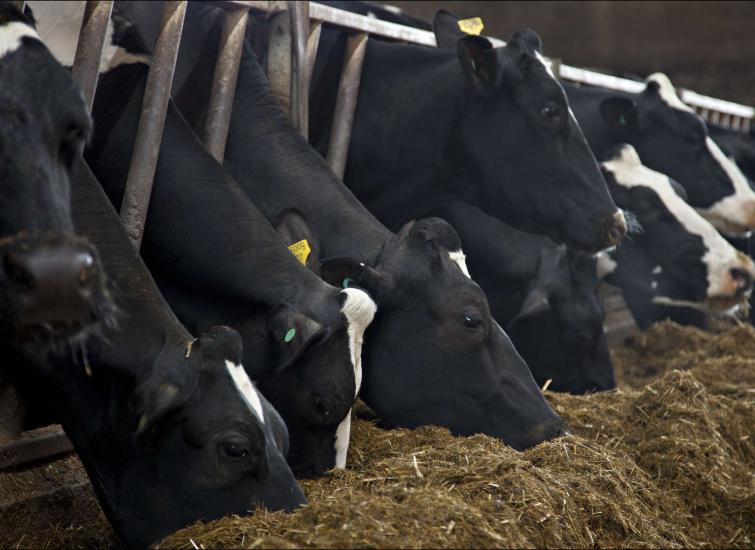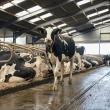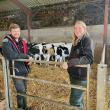Holistic View of Dry Cow Management
Advanced Nutrition’s Ruminant Nutritionist, Will Tulley BVM&S CertCHP MANCVS (Ruminant Nutrition) MRCVS, discusses the importance of the environment, comfort and nutrition in the dry period

The dry period has traditionally been viewed as a rest period for cows between lactations and as such, often hasn’t received the attention on farm that it requires. Whilst the non-lactating period is an opportunity for some body tissues to recover and regenerate for the next lactation it’s also a vital period to set cows and heifers up for the following lactation, with profound effects on subsequent health, production and fertility. Cow’s nutrient requirements increase hugely at and around calving, requiring significant metabolic changes, and nutrition and management in the dry and transition period have a huge effect on success rates.
We’re aiming for cows that:
- Calve without assistance producing a healthy calf.
- Produce enough high-quality colostrum to feed the calf.
- Remain free from metabolic or infectious disease.
- Rapidly increase in milk production to achieve peak yield at 60-80 days in milk.
- Become pregnant again by 100 days after calving, with minimal intervention.
Nutrition and diet formulation have a critical part to play in achieving our goals, but we also need to consider how we minimise stress for the cow, and if the condition of animals entering the dry period is correct. Recent research evidence shows that animals that either gain or lose body condition over the dry period are less likely to have a successful following lactation. To avoid this, cows need to be dried off in the same body condition in which we want them to calve – 3.0 to 3.25 on a five point scale. In high yielding herds, cows often become too fat prior to drying off, typically because they have taken too long to become pregnant in the previous lactation, and so have been overfed as their milk yield has declined prior to drying off. Similarly, heifers should calve at 22-24 months old, at 90% of mature body weight and body condition 3.0-3.25. Animals that are fatter or calve later typically eat less and mobilise more body fat, and so are at higher risk of metabolic disease and transition failure. Cows entering the dry period should also have their feet lifted and treated if required 2 weeks prior to drying off and receive appropriate drying off therapy for their udder health status.
When formulating rations for dry cows we need strategies to:
- Prevent excessive negative nutrient balance in early lactation.
- Control clinical and sub-clinical milk fever.
- Provide adequate trace elements for health and disease prevention.
Within four days of calving cows’ requirements for Glucose, Amino acids and fatty acids increases by between 200 and 450%. Cows are metabolically adapted to cope with this via the mobilisation and use of body fat and muscle. However, if this process is not well controlled, excessive loss of body tissue takes place and cows experience the consequences of excessive negative nutrient balance – ketosis and displacement of the abomasum. Rather than the energy density of the milking ration being to blame, it is dry matter intake in the immediate post calving period that has the biggest effect on nutrient balance.
Cows typically eat less in the 2 to 4 days around calving, and the higher the energy density of the dry cow diet the more pronounced this drop in feed intake. We therefore feed a controlled energy diet to dry cows to limit energy intake to around maintenance level of 100MJ/day, and to maximise dry matter intake in the crucial period around calving. Typically, this can only be achieved by adding significant quantities of straw or hay to dry cow diets. These high straw diets only work well if cows are unable to sort feed ingredients and so correct chop length of straw of around 2cm, and addition of water, or other liquid feeds to bind the rations together is essential. Other steps to maximise dry cow intakes are:
- Provision of adequate feed space – ideally 90cm per cow in the pre calving period.
- True ad-lib feeding
- Refusals should be 5% of amount fed.
- Cows must have access to feed for at least 23 hours per day. Adequate pushing up at feed faces is essential.
- Adequate lying space – a minimum of 1 usable cubicle per cow, or 1.25 square meters per 1000 litres of milk yield lying space for loose housed animals (e.g. 12.5 square metres per cow in a 10,000-litre herd)
- Daily feeding and removal of spoiled feed
- Adequate water access. At least 10cm per cow in calving groups, which must have a minimum of two water troughs to prevent dominant cows from stopping other animals from drinking.
- Avoidance of social stress. Mixing of new animals into a group depresses feed intakes for the following 2-3 days. If dry cow groups are mixed twice weekly cows will never eat the maximum amount, so limiting adding new cows to a group to once weekly.
Where dry cows are split into far off and close up groups, a slightly higher energy and protein density diet can be fed to the close-up cows to better prepare them for lactation. This can be a separate TMR, or where herd size isn’t large enough to allow that additional feeds, such as dry cow concentrates, can be top dressed onto the dry cow diet. This allows the addition of specific additives to aid with the prevention of excessive negative energy balance, as well as the use of calcium binders for the control of milk fever. The optimum time for cows to be in a close-up group is two to three weeks, and so cows should be moved into this group once weekly at between 14 and 21 days before due calving date. Cows diagnosed to be carrying twins should be moved a week earlier. Any moves or mixing closer to calving than this should be avoided and if a “just in time” move to pens is planned this should happen once the calf’s feet are showing during labour. Dry cow facilities should be sized to take account of any peaks in the calving pattern.
Diets for calving cows must also have a strategy for the control of clinical and sub-clinical milk fever. Sub-clinical milk fever, or low blood calcium without obvious clinical signs, can affect up to 50% of cows depending on lactation number and can significantly affect health, milk production and fertility. A recent study showed that sub-clinical milk fever cases are costing up to £60 for every cow in the herd. A DCAB approach has become common in recent years, with diets formulated to reduce potassium and often with the feeding of supplementary chloride or sulphate salts. Whilst results with these diets can be favourable, they require intensive management to avoid any variability, and can prevent the use of grass silage, or hays in dry cow diets as these often contain high levels of potassium. Evidence shows that this approach can be detrimental to feed intake. An alternative strategy and one we’d strongly recommend is the use of a calcium binder. We’ve been using X-Zelit on farms for a number of years and with great effect. Our customers report significant reduction in calving issues as well as sub-clinical and clinical milk fever, contributing positively towards cow health and comfort, but also improving farm profitability. The binder contains a zeolite which absorbs calcium within the gut, effectively feeding the cow a low calcium diet and requiring her to start to mobilise her own calcium prior to calving. Recent studies from Cornell University, suggest that cows fed a calcium binder, rather than a DCAB diet have significantly lower levels of sub-clinical milk fever in the period immediately after calving, and that cows that have normal calcium levels after calving are quicker to get back in calf.
Cows also experience a period of immunosuppression around calving and so are more susceptible to infectious disease. This is worsened if cows mobilise excessive body fat or suffer from hypocalcaemia. Appropriate mineral and vitamin supplementation can help optimum immune function.
Dry cow management is critical to the set up of your herd for the following and future lactations. Attention to detail in this area, looking from a 360 degree approach can really improve herd health and longevity.
Article excerpts also featured in the Dairy Farmer, June Issue.
〈 BACK














